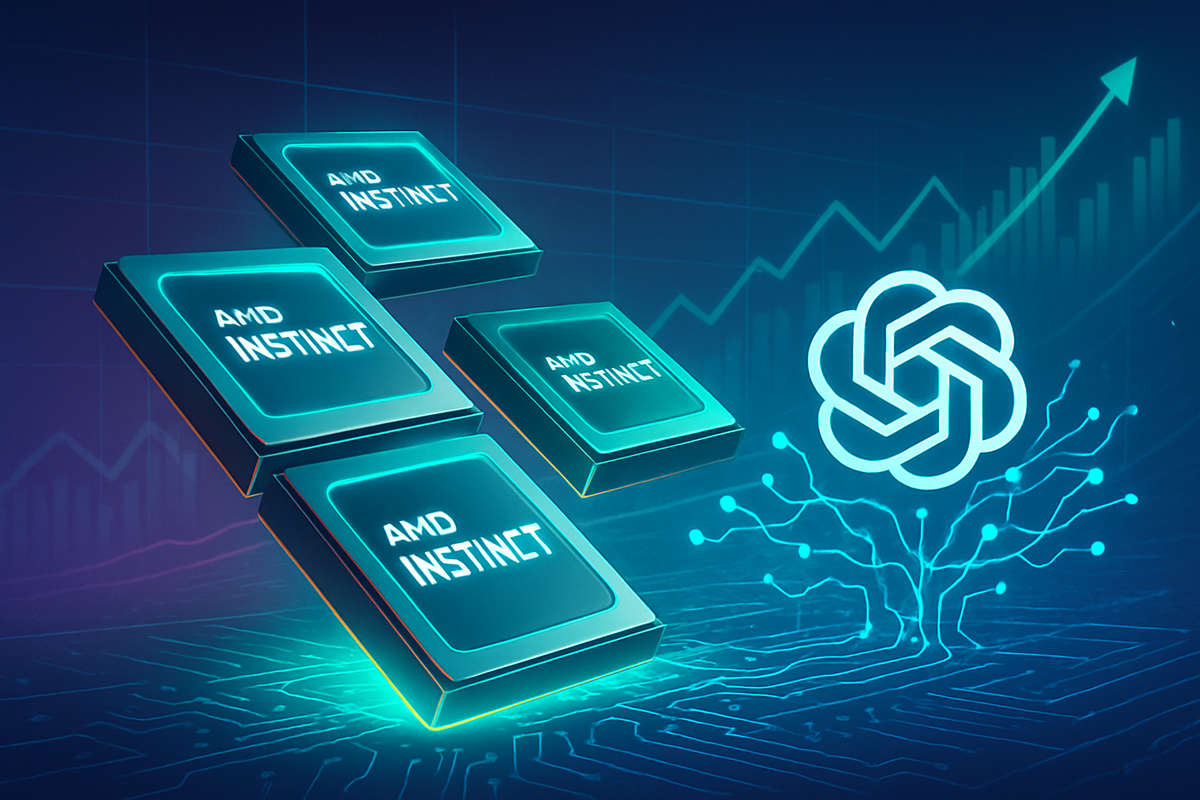
San Francisco, CA – October 6, 2025 – Advanced Micro Devices (NASDAQ: AMD) shares experienced an unprecedented surge today, propelling the semiconductor giant to record highs and injecting fresh momentum into the broader technology sector. The catalyst behind this dramatic ascent is a newly announced strategic multi-year, multi-generation partnership with artificial intelligence powerhouse, OpenAI. This monumental collaboration is sending shockwaves through the industry, signaling a significant shift in the competitive dynamics of the AI hardware market and contributing to the stock market's remarkable resilience amidst broader economic uncertainties.
The deal, which sees OpenAI committing to deploy up to 6 gigawatts (GW) of AMD's cutting-edge Instinct GPUs for its next-generation AI infrastructure, has been hailed by analysts as a game-changer. Investors are flocking to AMD, interpreting the partnership as a profound validation of the company's aggressive AI strategy and its technological prowess. The enthusiasm surrounding the announcement has not only lifted AMD but has also created a "halo effect" across the AI sector, pushing other related tech stocks higher and underscoring the immense and growing demand for AI compute power.
The AI Arms Race Intensifies: AMD Forges Landmark Deal with OpenAI
The strategic partnership between Advanced Micro Devices (NASDAQ: AMD) and OpenAI, unveiled on October 6, 2025, marks a pivotal moment in the burgeoning artificial intelligence industry. At the heart of this agreement is OpenAI's commitment to utilize up to 6 GW of AMD's powerful Instinct GPUs to fuel its expanding AI infrastructure. The initial phase of this ambitious deployment, involving 1 GW of AMD Instinct MI450 Series GPUs, is scheduled to commence in the latter half of 2026. This collaboration builds upon an existing multi-generational hardware and software partnership that previously included AMD's MI300X and MI350X series.
Beyond the sheer scale of the hardware commitment, the deal encompasses a deep technical collaboration, with both companies pledging to share expertise to optimize their product roadmaps for large-scale AI deployments. AMD's CFO, Jean Hu, indicated that this partnership is expected to generate "tens of billions of dollars in revenue for AMD," with some executives projecting over $100 billion in new revenue over the next four years from OpenAI and related clients. This substantial revenue potential underscores the transformative nature of the agreement for AMD's financial outlook.
A particularly intriguing aspect of the deal involves the issuance of a warrant by AMD to OpenAI for up to 160 million shares of AMD common stock, representing approximately a 10% stake in the company. These warrants are structured to vest upon the achievement of specific milestones, including the initial 1 GW deployment and subsequent scaling up to 6 GW, as well as AMD achieving certain share-price targets and OpenAI meeting technical and commercial milestones. Reports suggest that the final tranche of warrants could vest if AMD's stock price triples to $600 per share, aligning OpenAI's success directly with AMD's market performance.
The immediate market reaction to the announcement was nothing short of explosive. On October 6, 2025, AMD shares surged dramatically in pre-market trading, with gains reported between 25% and over 30%, adding an estimated $65-80 billion to its market capitalization. The stock reached an all-time high, trading around $210.08 per share, marking one of its largest single-day gains in nearly a decade. This robust performance signals strong investor confidence in AMD's ability to compete at the highest levels of the AI chip market and capitalize on the insatiable demand for AI compute.
Market Shapers and Shakers: Who Wins and Who Loses?
The landmark deal between Advanced Micro Devices (NASDAQ: AMD) and OpenAI is poised to create clear winners and losers across the technology and financial sectors. AMD, without a doubt, emerges as the primary victor. The partnership provides a massive revenue stream, validates its Instinct GPU architecture as a viable alternative for hyperscale AI deployments, and significantly strengthens its competitive position against long-time rival Nvidia (NASDAQ: NVDA). The warrant structure, tying OpenAI's equity stake to AMD's stock performance, further incentivizes a deep, collaborative relationship, potentially creating a "circular AI economy" that could drive sustained growth for both entities. This deal is not just about sales; it's about market perception and strategic positioning in a rapidly evolving landscape.
On the winning side, companies with exposure to AI infrastructure and server components are also experiencing a positive ripple effect. Monolithic Power Systems (NASDAQ: MPWR), a provider of power management solutions, and Super Micro Computer (NASDAQ: SMCI), a leading AI server manufacturer, both saw their stocks gain over 5% following the announcement. This indicates a broader investor confidence in the entire AI supply chain, as the increased demand for AI compute necessitates more robust and efficient supporting hardware. Any company that provides essential components, cooling solutions, or data center infrastructure for large-scale AI deployments stands to benefit from this intensified AI arms race.
While the immediate impact on Nvidia (NASDAQ: NVDA) stock was a modest dip of 0.2%, the long-term implications for its market dominance are significant. For years, Nvidia has held a near-monopoly on high-performance AI GPUs, making it the default choice for major AI developers. OpenAI's decision to diversify its supply chain and commit to AMD's hardware represents a strategic challenge to Nvidia's stronghold. While OpenAI CEO Sam Altman clarified that the AMD deal is incremental and that they still plan to increase Nvidia purchasing, the partnership undeniably introduces a formidable competitor and could put pressure on Nvidia's pricing power and market share in the future. Nvidia will likely need to innovate even faster and potentially adjust its strategies to maintain its leading position.
Beyond direct competitors, smaller AI hardware startups and niche component manufacturers might face increased pressure. With two titans like AMD and Nvidia vying for hyperscale contracts, the barrier to entry for new players could become even higher. However, for those with truly innovative technologies or specialized solutions that complement either AMD or Nvidia's ecosystems, there could still be opportunities for collaboration or acquisition. Ultimately, the deal accelerates the consolidation and specialization within the AI hardware market, favoring established players with the resources to scale production and R&D.
Broader Implications: A New Era for AI Hardware
The strategic alliance between Advanced Micro Devices (NASDAQ: AMD) and OpenAI transcends a mere business transaction; it marks a pivotal moment in the broader trajectory of the artificial intelligence industry, ushering in a new era for AI hardware. For years, Nvidia (NASDAQ: NVDA) has enjoyed near-unrivaled dominance in the AI accelerator market, a position solidified by its CUDA software platform and robust ecosystem. AMD's breakthrough with OpenAI signifies a credible and powerful challenge to this hegemony, suggesting that the AI hardware market is rapidly maturing beyond a single-vendor landscape into a more competitive and diversified ecosystem. This increased competition is beneficial for AI developers, potentially leading to faster innovation, more specialized hardware, and more favorable pricing.
The ripple effects of this deal are expected to be far-reaching, impacting not only direct competitors but also a wide array of partners and adjacent industries. For software developers and AI researchers, the availability of a powerful alternative to Nvidia's GPUs could spur the development of more hardware-agnostic AI models and frameworks, reducing vendor lock-in. Companies that build AI applications and services will benefit from a more competitive hardware market, which could translate into lower infrastructure costs and greater flexibility in deployment. Conversely, smaller chip manufacturers or those heavily reliant on a single dominant player might need to reassess their strategies to adapt to this evolving competitive environment.
From a regulatory standpoint, the emergence of a strong competitor to Nvidia in the AI chip space could potentially alleviate some antitrust concerns that might have arisen from a near-monopoly. Governments worldwide are increasingly scrutinizing the power of large technology companies, and a more balanced competitive landscape in critical sectors like AI hardware could be viewed favorably by regulators. While there are no immediate policy implications directly tied to this deal, the long-term trend towards diversification in the AI supply chain aligns with broader national interests in technological resilience and strategic independence.
Historically, such shifts in dominant technology providers are rare but impactful. One could draw parallels to the rise of Intel (NASDAQ: INTC) and AMD in the x86 CPU market, which fostered decades of innovation through fierce competition. Another comparison might be the diversification of cloud computing providers, moving beyond initial dominance by a few key players to a more varied landscape. The AMD-OpenAI deal suggests that the AI industry is entering a similar phase of accelerated competition and innovation, where no single company's leadership can be taken for granted. This dynamic promises a fertile ground for technological advancement, but also presents new challenges for companies needing to quickly adapt to shifting market allegiances and technological standards.
The Road Ahead: What Comes Next for AI and the Market
The monumental partnership between Advanced Micro Devices (NASDAQ: AMD) and OpenAI sets the stage for a transformative period in the artificial intelligence sector, promising both short-term shifts and long-term strategic realignments. In the immediate future, we can anticipate continued volatility and heightened interest in semiconductor stocks, particularly those with strong AI narratives. AMD's stock performance will be closely watched as investors gauge the execution of the OpenAI deal and the initial deployment of the Instinct MI450 Series GPUs in late 2026. This period will also see intensified marketing and R&D efforts from both AMD and Nvidia (NASDAQ: NVDA), as they vie for market share in an increasingly competitive landscape. Expect to see new product announcements and strategic alliances from both camps as they seek to solidify their positions.
In the long term, this deal could accelerate the development of an open and diversified AI hardware ecosystem. OpenAI's significant investment in AMD's technology, coupled with the warrant structure, suggests a deep commitment to fostering a robust alternative to existing solutions. This could lead to a more modular approach to AI infrastructure, where developers have greater flexibility in choosing hardware tailored to specific workloads, rather than being confined to a single vendor's ecosystem. We may also see other major AI developers and cloud providers follow OpenAI's lead, diversifying their own AI hardware supply chains to mitigate risks and capitalize on competitive pricing.
Potential strategic pivots or adaptations will be crucial for companies across the tech spectrum. For Nvidia (NASDAQ: NVDA), this means redoubling efforts in software innovation (CUDA), expanding its ecosystem, and potentially exploring new market segments or specialized AI applications where its dominance remains unchallenged. For AMD, the challenge will be to scale production efficiently, rapidly iterate on its Instinct architecture, and build a developer community as robust as Nvidia's. Other semiconductor companies and AI infrastructure providers will need to identify their niche, whether it's in specialized AI accelerators, interconnect technologies, or advanced cooling solutions, to thrive in this evolving environment.
Emerging market opportunities are vast. The deal underscores the insatiable demand for AI compute, driving innovation in areas like optical interconnects, advanced packaging, and energy-efficient data center designs. Companies that can provide solutions to these bottlenecks will find fertile ground for growth. Conversely, challenges include managing the immense capital expenditure required for AI infrastructure, navigating complex global supply chains, and addressing the environmental impact of large-scale AI deployments. The "circular AI economy" suggested by the warrant structure could become a new model for strategic partnerships, blurring the lines between customers, suppliers, and investors in the pursuit of AI dominance.
Concluding Thoughts: A Defining Moment in Tech
The strategic partnership between Advanced Micro Devices (NASDAQ: AMD) and OpenAI is undeniably a defining moment in the technology landscape, with far-reaching implications for the artificial intelligence industry and the broader financial markets. The immediate surge in AMD's stock, driven by a multi-year, multi-generation deal for up to 6 GW of Instinct GPUs, signifies a powerful validation of AMD's AI strategy and its capacity to challenge established market leaders. This event has not only reshaped AMD's trajectory but has also injected a renewed sense of competition and innovation into the critical AI hardware sector.
Looking forward, the market is poised for continued dynamism. The key takeaways from this event include the accelerating demand for AI compute, the growing diversification of AI hardware supply chains, and the emergence of more collaborative and financially intertwined partnerships between AI developers and hardware providers. The "circular AI economy" model, exemplified by OpenAI's equity stake in AMD, could become a blueprint for future strategic alliances, fostering deeper integration and shared incentives for technological advancement.
For investors, the coming months will be critical. They should closely monitor AMD's execution of the OpenAI deal, particularly the progress of the initial 1 GW deployment scheduled for late 2026. Attention should also be paid to how Nvidia (NASDAQ: NVDA) responds to this heightened competition and whether other major AI players announce similar diversification strategies. The performance of the broader AI infrastructure ecosystem, including companies involved in power management, servers, and data center solutions, will also offer insights into the overall health and growth trajectory of the AI market. This landmark deal is not just about a single company's success; it's a testament to the transformative power of AI and the fierce race to build the computational backbone of our intelligent future.
This content is intended for informational purposes only and is not financial advice






